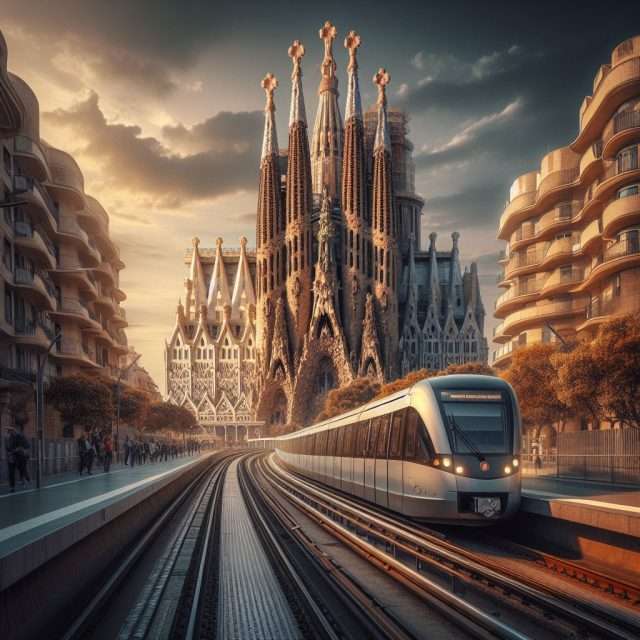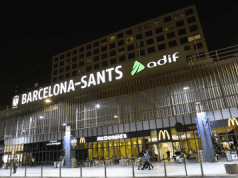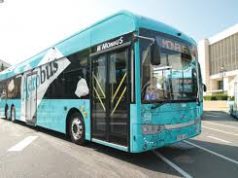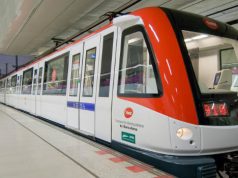Our complete guide on how to use Barcelona metro in 2024. Find out everything you need to know such as which tickets to buy, where to view metro maps and how to keep safe.
Arriving at a city as large as Barcelona can be an overwhelming experience. However, getting to grips with the city’s metro system can also become quite a challenge. I have put together the very best article I can to try to help travelers understand Barcelona’s metro system. Read on below and I will share my advice on how to use the Barcelona metro in 2024. I will explain how to buy tickets, and which tickets are the best to purchase. I will also share with you where to download maps and how to keep safe in the metro. Read on to find out all the best advice, information and tips on how to use the Barcelona metro.
General Advice On How To Use The Barcelona Metro
- The Barcelona metro has 12 lines, numbered from L1 to L11 and FM (the Montjuïc funicular). Each line has a different color and direction, which are indicated on the signs and maps at the stations and inside the trains. You can also download the official metro map here or use the Hola Barcelona app here to plan your routes and check the timetables.
- The metro operates from 5 a.m. to midnight from Monday to Thursday, from 5 a.m. to 2 a.m. on Fridays, and continuously from 5 a.m. on Saturday to midnight on Sunday. On public holidays, the metro may have different schedules.
- The metro stations are accessible by stairs, escalators, or elevators, and have indicators of the platform, direction, and next train. Some stations have more than one exit, so make sure you follow the signs to your destination.
- The metro is integrated with other modes of public transport, such as buses, trams, regional trains, and the airport shuttle. You can use the same ticket or card to switch between them, as long as you are within the same zone and the validity period. Barcelona has six zones, but most of the attractions are in zone 1, which covers the city center and the surrounding areas.
- The metro is generally safe and clean, but you should always be vigilant of your belongings and surroundings. This is especially important to take into account when trains and stations are busy. Avoid using your phone or other gadgets while on public transport, and keep your bags and backpacks in front of you with your hands on top. If you feel uncomfortable or threatened, you can get off at the next station or sit close to the driver or in a well-lit spot.
Planning Journeys on the Barcelona metro
- To plan your journeys, you can use the journey planner here or the app which will give you the best route, the estimated time, and the number of transfers. You can also download a metro map or the signs and maps at the stations to find your way.
- To use the metro, you need to buy a ticket or a card, which you can do at the ticket machines, the ticket offices, or online. You need to validate your ticket or card at the barriers before entering the platform, and keep it until you exit the system. If you lose or damage your ticket or card, you may be fined or denied access.
- To board the train, wait for it to stop and the doors to open, and let the passengers exit before entering. The doors will close automatically, so be careful not to get caught. Inside the train, you can hold on to the poles, straps, or handles, and pay attention to the announcements and screens for the next station and the line information.
- To transfer between lines, you need to follow the signs and maps to the corresponding platform, and validate your ticket or card again at the barriers. You can transfer as many times as you need, as long as you are within the same zone and the validity period. Some stations are connected by long corridors or require exiting and re-entering the system, so allow enough time for your transfers.
- To exit the system, you need to follow the signs and maps to the exit of your choice, and validate your ticket or card again at the barriers. Some exits have turnstiles that require pushing or rotating, while others have automatic doors that open when you approach. Once you exit the system, you can use the maps at the exit to orient yourself or find other modes of public transport.

Keeping Safe on the Barcelona metro
- The Barcelona metro is generally safe, but you should always be aware of the risk of pickpockets. Petty criminals will operate mainly on crowded trains and stations. They will use distraction techniques, such as asking for directions, dropping something, or pushing and shoving.
- To avoid being a victim, you should follow these tips:
- Carry your bags and backpacks in front of you with your hands on top, and never leave them unattended or out of sight.
- Do not carry your phone, wallet, or other valuables in your back or side pockets, but in a safe inside pocket or a pouch under your clothes.
- Do not use your phone or other gadgets while on public transport, as they may attract attention or make you less alert.
- Do not accept help from strangers to buy tickets, use the machines, or carry your luggage, as they may be trying to scam you or steal from you.
- Do not engage with people who approach you with a map, a petition, a bracelet, or a sob story, as they may be trying to distract you or rip you off.
- Be careful when entering and exiting the train, as pickpockets may try to snatch your belongings or jump off with them just as the doors close.
- If you notice or suspect any suspicious activity, alert the staff, the security, or the police, or use the intercoms or the emergency buttons on the platform or inside the train.
Buying Tickets on the Barcelona metro
To use the Barcelona metro, you need to buy a ticket or a card, which you can do at the ticket machines, the ticket offices, or online. There are different types of tickets and cards, depending on the number of journeys you will take.
To buy a ticket or a card, you can use the ticket machines, which are available at every metro station and accept cash, coins, or credit cards. The machines have different languages and are easy to use, but you should be careful of people who may try to help you or distract you. You can also buy a ticket or a card at the ticket offices, which are available at some metro stations and have staff who can assist you. The ticket offices have different opening hours, it is always best to purchase a ticket in advance.
To validate your ticket or card, you need to insert it or scan it at the barriers before entering the platform, and keep it until you exit the system. If you transfer between lines or modes of public transport, you need to validate your ticket or card again at the barriers, but it will not count as a new journey, as long as you are within the same zone and the validity period.
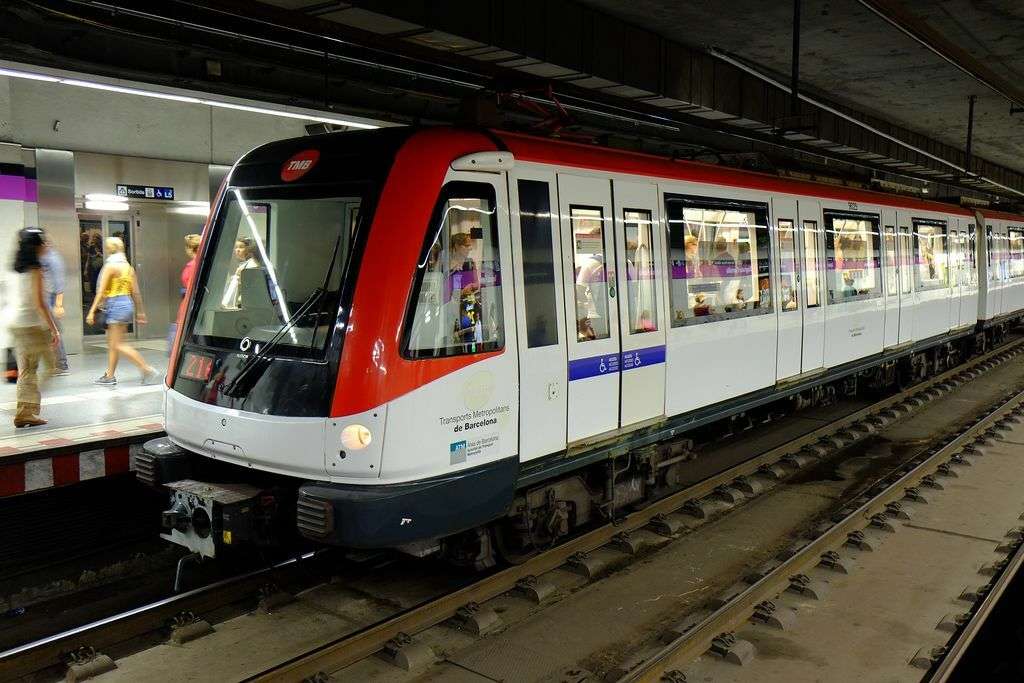
How to get from Barcelona airport to the city centre by metro
Barcelona airport, also known as El Prat, is connected to the city centre by the metro line L9 Sud (South), which has stops at both terminals T1 and T2. This is a convenient and affordable option to reach your destination in about 30 minutes. Another option, and in my opinion a better option than the metro, is to use the Barcelona aerobus. This bus takes you from Barcelona airport to the heart of the city centre.
Metro stations and connections
The L9 Sud metro line has 15 stations, from Aeroport T1 to Zona Universitària. Along the way, you can transfer to other metro lines or trains to get to different areas of the city. Here are some of the main stations and connections:
- Aeroport T1 and Aeroport T2: These are the stations where you can access the metro from the airport terminals. They are well signposted and easy to find. You can also take a free shuttle bus between the terminals if you need to.
- El Prat Estació: This is the station where you can switch to the RENFE Rodalies train, which is another option to get to the city centre or other nearby towns. The train runs every 30 minutes and takes about 20 minutes to reach Barcelona Sants, the main train station in the city.
- Europa | Fira: This is the station where you can switch to the FGC train, which is a regional railway service that connects Barcelona with other municipalities in the metropolitan area. You can also use this station to get to the Fira de Barcelona, the exhibition and convention centre that hosts many events throughout the year.
- Torrassa: This is the station where you can switch to the L1 metro line (red), which crosses the city from north to south and stops at some of the most popular attractions, such as Plaça Catalunya, Plaça Espanya, Arc de Triomf, and La Sagrada Familia.
- Collblanc: This is the station where you can switch to the L5 metro line (blue), which runs from east to west and stops at some of the most important landmarks, such as Diagonal, Sants Estació, Hospital Clínic, and Camp Nou, the stadium of FC Barcelona.
- Zona Universitària: This is the station where you can switch to the L3 metro line (green), which goes along the coast and stops at some of the most scenic spots, such as Passeig de Gràcia, Liceu, Drassanes, and Barceloneta.
Barcelona metro operating hours and frequency
The metro operates every day of the week, but the schedule varies depending on the day and the season. Generally, the metro runs from 5:00 am to midnight from Monday to Thursday. Weekends from 5:00 am to 2:00 am on Friday, and continuously from Saturday to Sunday. However, it is recommended to check the official website of Transports Metropolitans de Barcelona (TMB) for the latest updates.
The frequency of the metro trains depends on the time of the day and the demand, but it is usually around 7 minutes. You can check the waiting time on the screens at the stations or on the TMB app.
Metro ticket prices and options for the Barcelona metro
One important point in learning how to use the Barcelona metro is finding out how to purchase tickets. There are different types of tickets and travel cards available, depending on your needs and preferences. Here are some of the most common ones:
- Single ticket: This is a one-way ticket that costs €2.55 and allows you to travel on any metro line within the zone 1. You can buy it from the ticket machines at the stations. This is a good option if you use the metro very rarely or only need to make a single journey.
- Airport ticket: This is a special single ticket that costs €5.15 and allows you to travel between the airport and the rest of the metro network. You can buy it from the ticket machines at the airport stations or online. The best option if you only need to go to or from the airport by metro.
- T-Casual card: This is a multi-person travel card that costs €12.15 and allows you to make 10 journeys on any metro line or other public transport within the zone 1. You can buy it from the ticket machines at the stations or online. This is a great if you plan to use the metro or other public transport frequently during your stay.
- T-Usual card: This is a personal travel card that costs €21.35 and allows you to make unlimited journeys on any metro line or other public transport within the zone 1 for one month. You can buy it from the ticket machines at the stations or online. This is ideal for people that are staying in Barcelona for a long time or use the metro or other public transport every day.
- Hola Barcelona Travel Card: This is a personal travel card that allows you to make unlimited journeys on any metro line or other public transport within the zone 1 for 2, 3, 4, or 5 consecutive days. The prices vary depending on the duration, from €17.50 for 2 days to €40.80 for 5 days. You can buy it online or at the airport stations. This is a perfect if you want to explore the city with flexibility and convenience.
You can find more information about the tickets and travel cards on the TMB website or app. Remember to validate your ticket or travel card every time you enter or exit a metro station. Always keep your ticket with you until the end of your journey.
Tips and recommendations using the Barcelona metro
- The metro is a safe and reliable way to get around Barcelona. However, you should always be aware of your surroundings and your belongings, especially in crowded areas or during peak hours. Pickpockets are common in the city, so keep your valuables close to you and do not leave them unattended.
- The metro stations and trains are accessible for people with reduced mobility, as they have elevators, ramps, and adapted doors. However, some stations may have stairs or escalators, so check the accessibility information on the TMB website.
- The metro stations and trains have signs and announcements in Catalan, Spanish, and English. There shouldn’t be any problem finding your way or understanding the information. You can also use the TMB website or app to plan your route, check the timetable, and get real-time updates.
- The metro is a great way to discover Barcelona. It connects you with many of the most interesting and beautiful places in the city. You can also combine the metro with other modes of transport, such as buses, trams, trains, or bikes.
I hope my article has helped explain how to use the Barcelona metro. Although a rather daunting experience at first, the Barcelona metro is essential to get around the city. Using the Barcelona metro means you can easily visit all the fantastic sights and attractions. One thing is for sure, finding your way around on the metro will become easier with time. Just remember to plan your route in advance and keep a map of the Barcelona metro handy at all times.
